Grus Home Energy - Solar Panels Efficiency
Maximizing Solar Power: Innovative Strategies for Enhancing Solar Panel Efficiency
Maximizing Solar Power: Innovative Strategies for Enhancing Solar Panel Efficiency
With the increasing demand for sustainable and renewable energy sources, solar panels have become a popular solution for both residential and commercial energy needs. However, the efficiency of solar panels remains a critical factor in determining their effectiveness and overall contribution to energy generation. Solar panel efficiency refers to the amount of sunlight that can be converted into usable electricity. Over the years, advancements in technology have led to significant improvements, but there is still much room for enhancement.
One of the key strategies for improving solar panel efficiency is the development of new materials. Traditionally, solar panels are made from silicon, which has a relatively high efficiency rate. However, researchers are experimenting with alternative materials such as perovskite, a crystal-like structure that has shown potential for higher efficiency rates at a lower production cost. Moreover, tandem solar cells, which layer multiple types of materials, are being explored to capture a broader range of the solar spectrum and convert more sunlight into electricity.
Another innovative strategy is the use of solar concentrators. These devices focus sunlight onto a smaller, highly efficient solar cell. By concentrating the light, less solar cell material is required, which can reduce costs and increase the overall system efficiency. Additionally, solar trackers that follow the sun’s position in the sky can maximize the amount of light hitting the panels throughout the day, leading to a more consistent and increased power output.
Surface design and coatings also play a crucial role in enhancing efficiency. Anti-reflective coatings are applied to the surface of solar panels to reduce the loss of sunlight due to reflection. This ensures that more light is absorbed and converted into electricity. Texturing the surface of solar panels can also trap more light, while the development of clear, conductive coatings can improve the capture of light without obstructing it.
Efficiency can be further improved through better energy management. Smart inverters and power optimizers can help in managing the energy produced by solar panels more effectively. They ensure that the panels operate at their maximum potential, despite shading or debris that might partially cover the panels. Smart grid technology also allows for better integration of solar energy into existing power grids, ensuring that the energy produced is not wasted and is distributed according to demand.
Maintenance and cleanliness of solar panels are critical as well. Dust, dirt, and debris can accumulate on the panel’s surface, blocking sunlight and reducing efficiency. Regular cleaning and maintenance can prevent this build-up and ensure that solar panels operate at their optimal level. Additionally, cooling technologies are being developed to prevent solar panels from overheating, which can also diminish their efficiency.
In conclusion, increasing the efficiency of solar panels is a multifaceted challenge that involves advances in materials science, engineering, and energy management. By utilizing new materials, employing solar concentrators, improving surface designs, managing power more efficiently, and maintaining the cleanliness and temperature of solar panels, significant strides can be made in maximizing the power output of these renewable energy sources. As technology continues to evolve, we can expect to see even higher efficiency rates and a greater role for solar power in meeting the world’s energy demands.
Blog, Smart Home Automation , February 17, 2024 , Electric Vehicle (EV) Charging, Energy Consumption Analysis, Energy Management, Energy Savings and Profit, Heat Pumps Optimization, Home Battery Storage, Renewable Energy Technologies, Smart Grid Technology, Smart Metering, Smart Metering Systems, Solar Panels Efficiency, Sustainability in Home Energy
©2025 All Rights Reserved. Grus IoT Co.,Ltd.
